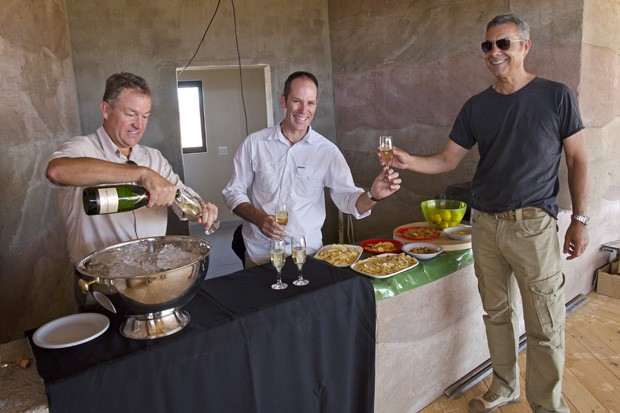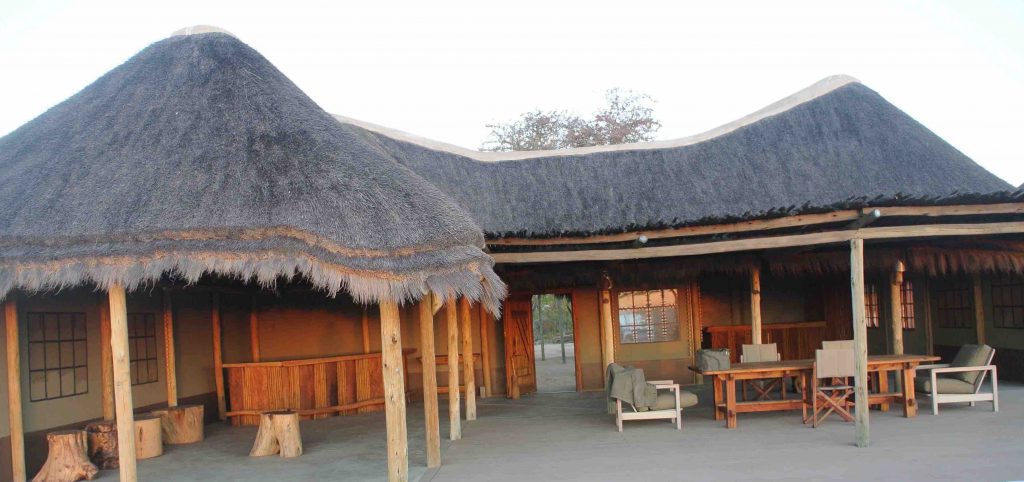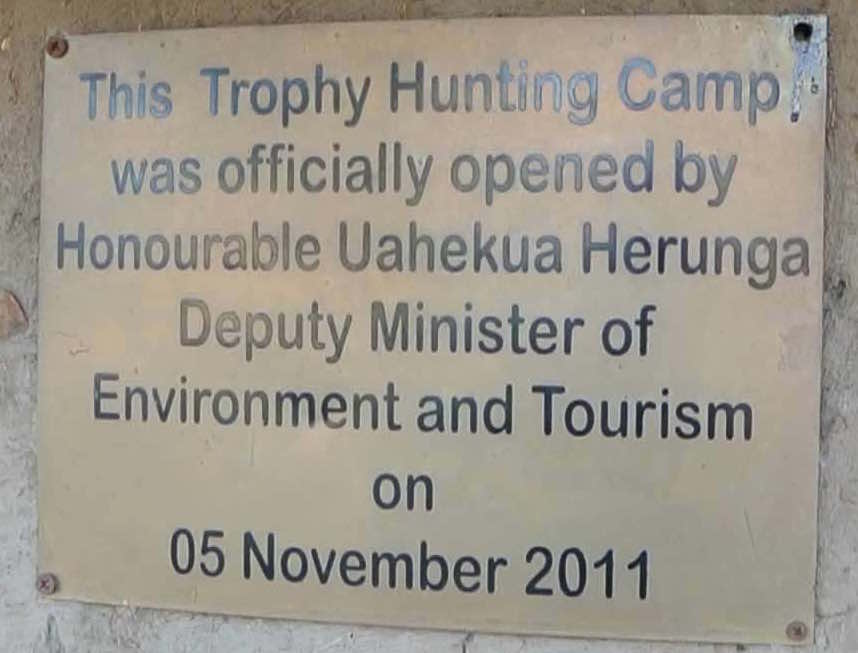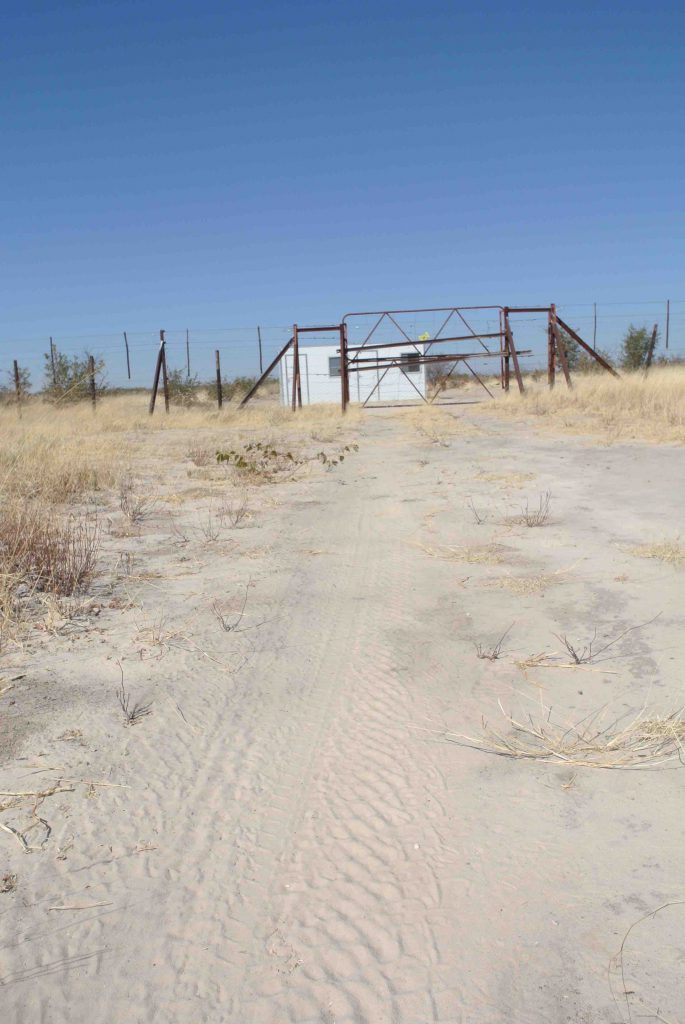
11 Aug ‘Trojan horse’ of Namibia’s rhino poaching crisis?
A mysterious, empty hunting lodge, avaricious tribal authorities and a backdoor into the Etosha National Park have emerged as possible keys to the ongoing decimation of Namibia’s critically endangered black rhino population. John Grobler investigates

Sheya Uushona: ghost lodge without guests. Photos by John Grobler
The ‘one chop’ chief
“My name is Vaino Kalimwe. Kalimwe means ‘just one chop’,” said the elderly Ogandjera headman with the red beret in fluent Afrikaans, his right hand cutting through the air into his left hand with a loud smack to illustrate what he meant. “Net een kap (Just one chop),” he repeated with a wolfish grin.
Behind him, the more senior chief, Sakarias Shikongo of Okahao, took a cagey approach: no name was given, as we were expected to know who he was – the official successor to the current Ogandjera “king” – and someone accustomed to deference.
Chief Shikongo was quite keen on the idea of elephant hunting, although “…we were told our elephants here are a little too small still”, he informed us.
“It’s the chief’s first time here at the lodge,” said the caretaker, who gave his name as Fillemon. They said they were at the lodge to meet its owner, Vitor Azevedo, later that night. As Azevedo’s trusted right-hand man of 26 years, Fillemon had been based at the still-incomplete Sheya Uushona lodge for seven years, he told us. As result, “The chief really listens to me, he trusts me.”
Which was odd: Chief Shikongo was in fact a regular visitor to the Sheya Uushona lodge, we later established. The Okahao tribal authority’s Sheya Uushona conservancy, so named for a famous Ogandjera king, owns 50% of the still-closed lodge. Construction had started in 2010.
A photographer and I had tracked the chief’s car for three hours along a maze of unmarked, deep sandy tracks snaking through the dense mopani flats of southern Omusati, situated immediately north of the Etosha National Park, to this strange hunting lodge called Sheya Uushona just outside the park’s fence.
It was clear from the tracks that this vehicle regularly used this track, which was the shortest, most direct route from Okahao to the lodge. For long stretches, the chief’s were the only tyre tracks we found along this route in the four-hour drive from Okahao.
Truth was, the chief had in fact had been to the lodge many times before. It was just one of many lies we were fed.
At the lodge we pretended to be scouts for a fictitious safari company, driving a South African-registered vehicle, and looking for hunting opportunities in this area that has become the epicentre of rhino poaching in Namibia.

Chief Sakarias Shikongo and Fillemon, in deep discussion about what to do with the unexpected guests
The hunt
Early that morning we had headed south out of Okahao to look for Onamatanga and Uutsathima, two villages in southern Omusati’s mopani plains where most of the 22 poachers currently facing charges for poaching in Okahao’s magistrate court were arrested a year ago. (See ‘The epicentre of Namibia’s rhino poaching‘)
Both these villages are located inside the Sheya Uushona conservancy, a 5,000-square kilometre communal conservation area immediately north of Etosha, created in 2005 as part of the Namibian government’s community-based natural resource management (CBNRM) model.
Considered the African conservation success story, Namibia’s CBNRM programme is touted by the World Wildlife Fund as a leading example of successfully integrated natural resource development and as a means of transferring some of the benefits of living with wildlife to local communities.

The lodge was officially ‘opened’ in November 2011, but remained closed as the owners converted it into a larger tourism camp. It remains incomplete and under construction – five years later
Officially opened in late 2011 by then deputy minister of environment and tourism Uahekua Herunga as a hunting lodge, it was subsequently converted from a three-chalet affair to a nine-chalet tourism lodge. It’s hard to not see why: the only game we spotted on the four-hour drive was a small herd of very nervous hartebeest at the salt pan.
Work on completing construction was halted on instructions of the Ministry of Environment and Tourism (MET) in 2014 “… because of the rhino poaching problem”, Fillemon confided.
We feigned disinterest and commented instead on the beautiful view over the snow-white Ogandjera salt pan, famed among the local people for its mineral salt.
On the way down, we had stopped at Amarika, a cattle post settlement of Hai//Om San, Ogandjeras and Hereros, to sip tombo (fermented sugar water, sometimes flavoured with old batteries) and ask some delicate questions about rhino poaching.
“Ask that man in that car, he can maybe help you,” said one, pointing at a dark-metallic pick-up driving past. Garrulous until now, he fell silent: rhino poaching was not a popular topic here.
And so we followed that car for hours. The chief’s tracks led to this unusual spot where the unfinished lodge rose like a mirage above the brilliant white Ogandjela salt pan: beautifully built but incomplete and empty of life. At the turn-off from the main track, we found signs of our quarry stopping, and two sets of footprints of people who got picked up and then driven in the direction of the fence, 3km further south, and then returning.
As we pondered our next move – to the lodge or to the fence? – the pick-up suddenly emerged from a side-track. The driver, dressed in a grey Cuban-style safari suit, was perturbed by our presence, swallowing a few times before responding to our greetings and requests for directions to the lodge. “Just drive in, you will find Fillemon at the lodge,” he said. In the back of the pick-up, three young men talked agitatedly among themselves.
We first followed the pick-up’s tracks to the lodge’s servants quarters: two rows of neat canvas huts raised on stilts, facing each other across a communal cooking and dining area. A man in blue over-alls – “Johnny from Rehoboth” – was sitting on the stairs of the first hut, with a half-smile, half-frown on his face. Fillemon was up at the lodge, he said.
Fillemon – literally Portuguese for “my son” – was waiting for us at the lodge’s parking area, a slight figure with a hooded look under his over-sized bush hat and sunglasses. As we got out of the car, his attitude changed as if a switch had been thrown: the happy employee, eager to show us around and lamenting the fact that he could not accommodate us because there was no furniture in the chalets yet.
We were shown beautiful wood work in the lapa area and chalets, but the kitchen was still under construction. Only the two guides’ chalets were furnished and the beds freshly made up in one, as was one room in the manager’s house. Everything else was empty – and seemed always to have been so.
As we returned to the main area after the guided tour, chiefs Kalimwe and Shikongo, accompanied by Shikongo’s daughter, appeared: they must have been the figures we had spotted walking along the pan’s edges as we arrived. They had come to fetch some of the famed mineral salt, and we could see the driver and three helpers down in the pan, loading salt on to the pick-up.

A map of the Sheya Uushona conservancy and lodge shows their location next to Etosha National Park, and the gate between the two
Waiting for Vitor
The safari-suited driver consulted with the chiefs until another vehicle arrived at the lodge. Inside was “George the builder”, responsible for the kitchen’s construction, who seemed suspicious of us at first.
He relaxed a little when he saw us chatting to Chief Shikongo. Yes, he said, he was the driver who had passed us along the track between Okahao and America: he went to get cigarettes and cool drinks for the policemen stationed at the nearby Etosha gate, he explained. He did not give his surname, but we later found out he was George Claassen. He then disappeared, seemingly to confer with Chief Kalimwe.
We inquired about a camping site, seeing as the lodge was not operational, and suggested we could camp somewhere along the Etosha fence. That idea did not sit well with Fillemon: no, out of the question, he said. Too dangerous, there are lions and hyenas here, the police could shoot at us, he warned.
But he would ask Chief Shikongo – who was the boss of the conservancy – if we could camp at the lodge site. A long conversation between Fillemon and Chief Shikongo ensued; Fillemon disappeared for a while as George also had a chat with Chief Shikongo before also disappearing. A few minutes later, we saw his white pick-up head out across the salt pan; the man in the safari suit seemed to be with him, because he had also disappeared.
Fillemon reappeared with good news: we could use the lapa’s fireplace to cook, and then use one of the guide huts to sleep in – the beds were ready. The chiefs took their leave, saying the meeting with Vitor Azevedo was postponed to the next day. Vitor was delayed somewhere and would not make it, we were told.
By now, the sun was sinking below the horizon, and to the East the full moon – a gloriously bright “poachers’ moon” – was rising, making the pan glow in an unearthly white light. We decided that we’d like to talk to Johnny at the workers’ quarters, who surely would be happy to see someone carrying a six-pack of cold beer: it looked pretty lonely out there, especially if you were clearly not part of the larger group.
At the workers’ quarters, another surprise awaited: Fillemon and the three young men, all seemingly from Ondongwa, were not very excited to see us, in spite of their having not seen much company in the seven months they said they had been here. Which was odd: they clearly were not builders or cleaners, unlike Johnny sitting at his own fire right next to theirs.
Fillemon, although older, was doing the cooking and cleaning for the three younger men. Their names? Hafeni, Petrus and Van Wyk. Although much younger, they did not bother getting up for introductions. When a hyena they had been feeding scraps to came too close, they got up as a group and rushed at it: they were clearly used to dealing with wild animals in the bush.
The beer shared out, the conversation faltered. We returned to our luxurious cooking facility, the sunken fire-pit in front of the lodge. Of the lion, hyena and other game they claimed drank every night at the waterhole, there was no sight, in spite of the brilliant moonlight. Like the rest of southern Omusati, the pan remained devoid of any stirrings of wildlife.
The back door
The next morning, we said our good-byes and drove down to the pan to photograph the lodge in the morning light. George the builder suddenly came driving up at speed: he had gone off to make a phone call from the closest spot with cellphone connectivity, about 40km west along the old southern cut-line road, he said. His car’s brakes had seized up, so he had had to spend the night in the cab. But his car braked normally and he looked fresh.
We then drove out as if to leave the lodge area and, when we were sure we were not being watched, turned around and drove past the lodge to the Etosha park fence along a well-used track. At the fence, we encountered an old gate in the game-proof fence; beyond it, a new pre-fabricated hut that has not seen any use, judging by the length of grass at the front of its doors.

So who was using this gate as a pedestrian entry into the Etosha Park – right into the area where most of the black rhinos have been poached?
We cut the tracks: two vehicles, the chief’s pick-up and a little later, George’s pick-up with its distinct tyre tracks had driven up to this point the previous afternoon. Two men, judging by shoe size, had got off, climbed over the gate and walked past the hut.
A fresher set of vehicle tracks – most likely an MET Land Cruiser – had then arrived from along the western boundary and stopped. One set of shoe prints got in on the passenger side and the other in the back of the vehicle, which then drove south into the park.
The MET later confirmed to Oxpeckers that Sheya Uushona had the right to enter the park to fetch water – the water around the lodge is completely undrinkable – and that they had the right to conduct game drives via this gate into the park over a 50km radius.
But although there was a set of tyre tracks exiting the park during the previous week, the gate itself showed signs of repeatedly having been climbed over. The wires were sagging from having been repeatedly stepped on, and the double electric fence – supposedly rebuilt as part of a R2-million per kilometre upgrade – was not working.
The lodge had never had guests, apart from a marketing tour Azevedo and his marketing team had done with the Brazilian magazine Epoca in January 2015. Fillemon had confirmed that visit: ours was the first visit by outsiders since then.
So who was using this gate as a pedestrian entry into the Etosha Park – right into the area where most of the black rhinos have been poached?
It raised many questions, still unanswered: why was this gate built here in the first place? Who were the two men who entered the park, and more importantly, who had picked them up? All MET vehicles used in the park had tracking devices installed, so it should be relatively easy to find that out from the park authorities, we reasoned.
Meanwhile, there was George the builder’s strange overnight disappearance and return: why do a five-hour drive to Okahao and back, just to satisfy someone else’s nicotine fix – only to do half that same distance again nearly immediately afterwards, just to just make a phone call you could have made from Okahao earlier?
We tracked George’s spoor back west for 70km along the deep sandy track, losing it a few times until we found it again at the junction with the newly tarred Kamanjab-Ruacana road. Judging by the prints, he had stopped there for a while; shoe prints that looked like they belonged to the man in the safari suit had got out and into another vehicle, after which George’s vehicle had turned north onto the road, heading towards Omakange.
George, we figured, most likely had spent the evening at Omakange, a sprawl of corrugated-zinc bars and huts at the intersection between Kamanjab, Okahao, Ruacana and Opuwo. It is also a notorious poachers’ nest, situated halfway between the Etosha park and Ruacana, where one can cross the Angolan border on foot.
The next day, as we were leaving Opuwo, I received a call. An Inspector Shapumba of the Namibian police, who knew my full name, that I was at the Sheya Uushona gate in a foreign-registered green vehicle, wanted to speak to me about illegally entering Etosha park.
How he could have known what colour car we drove from footprints was not clear, so I stalled for time, telling him my battery was low and we were heading for Epupa. I did not correct him when he asked if we were going to Ruacana, and offered instead to meet a day later in Outjo, closest town to Okaukeujo.
“I will see if it is possible,” came the reply. It wasn’t: Inspector Shapumba never called again.

Lodge owner Vitor Azevedo on the right, with former marketing team Rob Moffat (left) and Piers L’Estrange (centre) during a January 2015 trip with a Brazilian magazine to the lodge, the only other time the lodge had guests. Photo: Epoca magazine
The rule of nobody
Back in Windhoek a week later, obtaining answers from the MET met with bureaucratic wet-blanketing or, as American political theorist Hannah Arendt described it, “the rule of nobody”. Details of anti-poaching operations and rhino fatalities in Etosha could not be shared for security reasons, Permanent Secretary Dr Malan Lindeque admonished.
While we had no positive proof of Sheya Uushona being directly involved in poaching, the mere fact that men were dropped at the Etosha fence and then driven into the park on a full moon night raised serious questions that the MET declined to answer.
Nobody was asking questions about why a ghost lodge’s workers or its conservancy members were regularly entering Etosha park on foot, or why 47 suspected poachers arrested in June 2015 all came from the two villages Onamatanga and Uutsathima, just south of Omakange and inside the Sheya Uushona conservancy.
Nobody was asking questions either of Vitor Azevedo and his Namibia Exclusive Safaris (NES), a hunting safari business that owns three more such luxury lodges: Omatendeka Lodge in the Grootberg conservancy, Sorris-Sorris Lodge and the Xaudom Lodge, inside the Khaudom National Park alongside the northern Botswana border.
Exclusive Safaris also owns a hunting concession outside the Khaudom park, and the lodge – at R14,900 a night per chalet and R500 for a campsite – was clearly aimed more at the well-heeled sports hunting market. Of all four lodges, constructed at an estimated cost of R40-million all in, only Sorris-Sorris was currently operational, NES admitted.
Elsewhere, Azevedo claimed to have invested over US $10-million in his Namibian lodges – nearly R133-million at current exchange rates.
Half the investment came from the United States Millennium Challenge Account, invested on behalf of local communities in Azevedo’s ventures, said a source who was familiar with the 2005 creation of the Sheya Uushona and Uukwaludhi conservancies in the Omusati region.
Azevedo got a foot in the door by first assisting in the feasibility studies, and then entering into private treaties with the communal conservancies hiring the French consultant Vincent Guillemin, whose employment was part of the European Union funding conditions, he said.
In effect, Azevedo, with no previously known track record in the Namibian tourism industry, had obtained a back door into two national parks and a rhino-rich conservancy in this manner by building lodges where no one else would or could. All are remote and can only be reached by poor roads, a logistical obstruction his company said was the main reason for their slow progress.
Namibia Exclusive Safaris denied that the Sheya Uushona staff were in any way involved in assisting anyone to enter Etosha park illegally. None of them had a key, and could only enter the park with the permission of the MET or the police, Guillemin, now the liaison and strategic operations manager for NES, said.
In response to questions about who the three young men were, Guillemin said NES was employing “… three gentlemen who are currently starting to build our staff houses”. The staff quarters – neat raised tents with high roofs – were, however, completed a year ago by another contractor, Oxpeckers confirmed independently.
Like in western Etosha south of Sheya Uushona, the rhinos in the Grootberg conservancy where NES built the now-closed Omatendeka lodge had been hard hit since 2012, with seven killed in the nearby Klip River in December 2014 alone. And north of the Khaudom National Park along the Western Caprivi, poachers have been taking a heavy toll on elephants.
Guillemin denied that poaching at Omatendeka and Khaudom had increased since NES started construction activities: “According to our observation, to the contrary, the poaching seems to have decreased … Animals are far more relaxed than they used to be.
“Our hospitality business is based on wildlife sighting, so it is obvious that poaching is a big threat to the success of our future operations. We are aware of incidents in rhino poaching in Omatendeka Conservancy, but to our knowledge, these incidents have occurred a considerable distance from the site of our lodge,” Guillemin wrote in reply to questions emailed to NES.
Little is known about Vitor Azevedo: born in Xangongo as the second son of Angolan refugees forced to flee to then South West Africa in 1975, he had started out buying and selling goods. According to the profile published in early 2015 in the Brazilian Época magazine, he then started dealing in fish and opened a string of successful restaurants all over South Africa.
No independent confirmation of Azevedo’s career as successful restauranteur could be found. He did, however, acquire a second profession, Época reported: dealing in rough diamonds, an illegal activity in Namibia, South Africa and Botswana.
“In South Africa , he also learned to know and evaluate brilliant [diamonds]. In a land full of rough diamonds – South Africa and Namibia – his second vocation has become a sophisticated profession,” the magazine reported.
Guillemin took exception to questions about Azevedo’s alleged involvement in the illegal diamond trade, and how he was funding his luxury lodge empire. “Mr Azevedo is not a diamond dealer – that is a serious allegation. Mr Azevedo does not have (nor has he ever had) a criminal record,” Guillemin stated.
Azevedo is known to have been partners with local diamond dealer Matthew Hamutenya, of the Millennium Diamond Corporation in Safarihoek, in another game farm on the south-eastern boundary of Etosha park. Azevedo is believed to have sold his interest in Safarihoek recently, and various other sources said Azevedo was looking for a new investor in NES.
Guillemin said questions about how Azevedo was funding his luxury lodge empire would be answered in person by Azevedo.
This investigation continues. – oxpeckers.org
